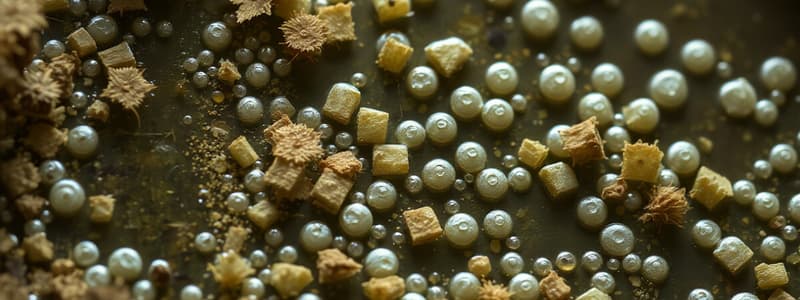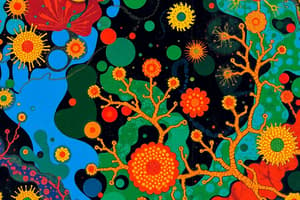Podcast
Questions and Answers
What color indicates the surface depth of a biofilm when observing through phase contrast microscopy?
What color indicates the surface depth of a biofilm when observing through phase contrast microscopy?
- Red (correct)
- Green
- Yellow
- Blue
What substance is used to stain a biofilm developed on stainless-steel to visualize nucleic acids?
What substance is used to stain a biofilm developed on stainless-steel to visualize nucleic acids?
- Crystal Violet
- DAPI (correct)
- Iodine
- Methylene Blue
What distinguishes a microbial mat from a standard biofilm?
What distinguishes a microbial mat from a standard biofilm?
- Microbial mats are made up of single-celled organisms only.
- Microbial mats are extremely thick and consist of various microorganisms. (correct)
- Microbial mats are less complex than biofilms.
- Microbial mats can only develop in freshwater environments.
What environmental condition is often associated with the presence of microbial mats?
What environmental condition is often associated with the presence of microbial mats?
Which type of bacteria are primarily found in iron-oxidizing microbial mats?
Which type of bacteria are primarily found in iron-oxidizing microbial mats?
What is the role of the Diel cycle in relation to microbial mats?
What is the role of the Diel cycle in relation to microbial mats?
Which process is most associated with the formation of extracellular glucans in a dental biofilm?
Which process is most associated with the formation of extracellular glucans in a dental biofilm?
What indicates the depth within a biofilm when stained with iodine solution?
What indicates the depth within a biofilm when stained with iodine solution?
What significant paradigm in microbiology involves isolating organisms from complex communities?
What significant paradigm in microbiology involves isolating organisms from complex communities?
Which bacterium did Robert Koch discover as a cause of anthrax?
Which bacterium did Robert Koch discover as a cause of anthrax?
What medium did Koch develop for obtaining pure cultures?
What medium did Koch develop for obtaining pure cultures?
What was the main point of Oscar Brefield's statement about working with impure cultures?
What was the main point of Oscar Brefield's statement about working with impure cultures?
What is the significance of the zone of no bacterial growth observed in Fleming's experiment?
What is the significance of the zone of no bacterial growth observed in Fleming's experiment?
What technological advancement did Koch's pure culture paradigm provide for microbiology?
What technological advancement did Koch's pure culture paradigm provide for microbiology?
Which disease did Robert Koch NOT study directly in his research?
Which disease did Robert Koch NOT study directly in his research?
What discovery resulted from Fleming's examination of an impure culture contaminated by Penicillium?
What discovery resulted from Fleming's examination of an impure culture contaminated by Penicillium?
What kind of measurements are sufficient in many studies for assessing microbial activities?
What kind of measurements are sufficient in many studies for assessing microbial activities?
Why is it important to use proper killed cell controls in chemical assays?
Why is it important to use proper killed cell controls in chemical assays?
Which method increases the sensitivity of measuring metabolites in microbial activity assessments?
Which method increases the sensitivity of measuring metabolites in microbial activity assessments?
What types of substances can microsensors detect based on electrochemical reactions?
What types of substances can microsensors detect based on electrochemical reactions?
What can small glass electrodes connected to microsensors measure?
What can small glass electrodes connected to microsensors measure?
In measuring microbial activities in coral, what was used for calibration?
In measuring microbial activities in coral, what was used for calibration?
What is a characteristic of microsensors used in microbial activity measurement?
What is a characteristic of microsensors used in microbial activity measurement?
How is the current in a microelectrode affected in the presence of a substrate?
How is the current in a microelectrode affected in the presence of a substrate?
What is the significance of the Winogradsky column?
What is the significance of the Winogradsky column?
What was one of Martinus Beijerinck's major contributions to microbiology?
What was one of Martinus Beijerinck's major contributions to microbiology?
Which statement correctly describes the concept of 'microbial ubiquity'?
Which statement correctly describes the concept of 'microbial ubiquity'?
What did Cornelius Bernardus van Niel contribute to our understanding of photosynthesis?
What did Cornelius Bernardus van Niel contribute to our understanding of photosynthesis?
Which of the following best describes chemoautotrophy?
Which of the following best describes chemoautotrophy?
Who is considered the founder of soil microbiology?
Who is considered the founder of soil microbiology?
What key concept did Albert Jan Kluyver help promote in microbiology?
What key concept did Albert Jan Kluyver help promote in microbiology?
What role did Sergei Winogradsky play in the understanding of element transformations?
What role did Sergei Winogradsky play in the understanding of element transformations?
What is the goal of an enrichment culture?
What is the goal of an enrichment culture?
Which of the following best describes the contribution of the Dutch Delft School to microbiology?
Which of the following best describes the contribution of the Dutch Delft School to microbiology?
What is the definition of a population in microbial ecology?
What is the definition of a population in microbial ecology?
What is the significance of microbial guilds in an ecosystem?
What is the significance of microbial guilds in an ecosystem?
Which of the following accurately describes an ecosystem?
Which of the following accurately describes an ecosystem?
What is species abundance in microbial ecology?
What is species abundance in microbial ecology?
What role do heterotrophs play in microbial metabolism?
What role do heterotrophs play in microbial metabolism?
Which characteristics are essential for microbial growth?
Which characteristics are essential for microbial growth?
Which of the following accurately describes the function of biogeochemical cycling?
Which of the following accurately describes the function of biogeochemical cycling?
Which of the following is NOT a type of extremophile?
Which of the following is NOT a type of extremophile?
What limits the study of microorganisms in their natural environments?
What limits the study of microorganisms in their natural environments?
Which statement best describes nutrient cycling in ecosystems?
Which statement best describes nutrient cycling in ecosystems?
What type of environments do extremophiles thrive in?
What type of environments do extremophiles thrive in?
What is the primary focus of microbial ecology as a field of study?
What is the primary focus of microbial ecology as a field of study?
In the context of microbial diversity, what does species richness refer to?
In the context of microbial diversity, what does species richness refer to?
What is the main activity measured when studying microorganisms within an ecosystem?
What is the main activity measured when studying microorganisms within an ecosystem?
Flashcards are hidden until you start studying
Study Notes
### Microbial Ecology
- Study of inter-relationships between microorganisms and their environments, from the individual cell to the ecosystem level.
General Ecological Concepts
- Ecosystem: all organisms and abiotic factors in a specific environment.
- Habitat: portion of an ecosystem where a community could reside.
- Population: a group of microorganisms of the same species residing in the same place at the same time.
- Community: consists of populations living in association with other populations.
- Guild: sets of metabolically related microbial populations that interact with macroorganisms and abiotic factors in the ecosystem.
- Niche: habitat shared by a guild, supplies nutrients and conditions for growth.
- Species richness: total number of different species present in an ecosystem.
- Species abundance: proportion of each species in an ecosystem.
Microbial Ecology Considerations
- The role of microbes in ecosystem niches & biogeochemical cycling.
- Microbes are found in a wide variety of environments including "extremes" such as high and low temperatures, pH, pressure, salinity, and anoxic habitats.
Microbial Ecology Objectives
- Biodiversity of microorganisms in nature and interactions within communities.
- Measurement of microbial activities and monitoring of effects on ecosystems.
- Typical microbial activities measured:
- Primary production of organic matter (phototrophic, chemolithotrophic activity)
- Decomposition of organic matter (chemoorganotrophic/heterotrophic activity)
- Biogeochemical cycling of elements
Microbial Activity Measurements in Nature
- Direct chemical measurements: lactate, SO42−, and H2S can be measured using chemical assays.
- Radioisotopes: high sensitivity for microbial activity measurements.
- Microsensors (microelectrodes): sensitive instruments used to measure pH, oxygen, N2O, CO2, H2, H2S, and other substances.
- Nanosensors: based on octaethylporphine ketone platinum (II) for measuring dissolved oxygen concentrations in coral photosynthetic activity.
Studying That Suits You
Use AI to generate personalized quizzes and flashcards to suit your learning preferences.



